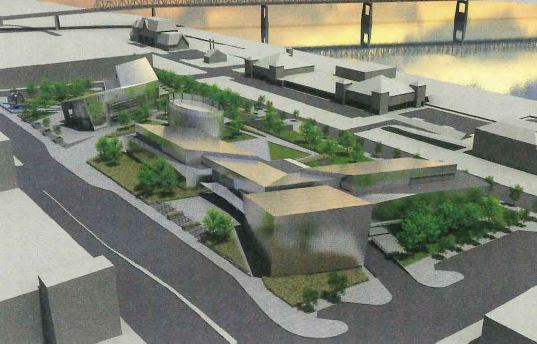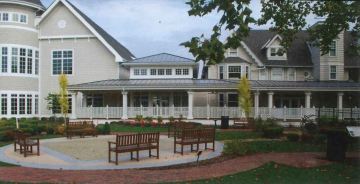
This article originallly appeared in the January/February 2010 edition of Museum magazine.
For the past two decades, museums have enjoyed a building boom. Issues of Museum magazine have been graced for years with a variety of freshly completed museum facilities. AAM reported in 2009 Financial Information that close to 25 percent of museums were engaged in capital projects, and the Mid-Atlantic Association of Museums has hosted five successive conferences on building museums.
But now scary things are happening—staff layoffs, furloughs, canceled exhibitions, shortened hours, deaccessioned collections, and even closures and bankruptcies.
This scenario has created huge challenges for museums intending to launch or proceed with costly renovations or expansions. Yet the fundamental need to create more useful and successful facilities remains. Museums advancing their visions in a tough economy are taking a variety of approaches, including postponing projects, rethinking or downsizing projects, seeking creative financing options, phasing and extending time frames, merging or collaborating with other organizations, and tightening project management.
The evidence is clear that times are tough for cultural institutions. A February 2009 report by Johns Hopkins University’s Center for Civil Society Studies revealed a dramatic slowdown in the nonprofit sector. More than $166
billion in building projects were found to be on hold due to lack of funding, and museums were the highest category reporting stalled projects. Similarly, a 2009 Association of Art Museum Directors member survey revealed that only 25 percent are moving forward on expansion plans—a drop from 40 percent in 2008 and 66 percent in 2007. The
same survey reported significant decreases in endowments, earned revenue, and individual, government, and corporate support.
At the same time, architectural firms are feeling the pinch. The U.S. Bureau of Labor Statistics reported that architectural firms had lost about 8 percent of their workforce in the final half of 2008. David Greenbaum, vice president of the SmithGroup and a veteran of many museum construction projects, says that business was flat for a long period until spring 2009 finally brought a flurry of requests for proposals—mostly for federally funded projects.
In this climate, some museums have been forced to simply halt major projects. The Theodore Roosevelt Museum in Oyster Bay, N.Y., for example, canceled its planned $90 million museum project, citing a drop in endowment and resulting operating cuts. The University of Arizona suspended work on a $130 million building planned to house its Science Center and State Museum in Tucson. After years of planning a new facility, the Children’s Museum of Los Angeles declared bankruptcy when its major funder was charged by the U.S. Securities and Exchange Commission for investment fraud. And the Gulf Coast Art Museum in Largo, Fla., announced that it will give up plans for a new facility and close to the public.
Others have been waiting to see how things unfold before plunging into new projects. Exhibition designer Patrick Gallagher, whose firm has worked on several museum expansions, believes that projects costing more than $100 million are most likely on hold. The Saint Louis Art Museum, for example, announced in late 2008 a delay in groundbreaking for its $125 million, David Chipperfield-designed building—a project that had been in the works for most of the decade. In April 2009, the board announced various reductions in revenue and necessary budget cuts, but they also reaffirmed their desire to begin work on the Chipperfield project before the end of 2009.
Financing such mega-projects has simply become too expensive. Unsurprisingly, financial institutions have tightened credit and are reluctant to loan funds for deals that don’t offer security. Larger projects are more complicated and in many cases will be challenging to sustain after opening. Small to medium-sized projects, according to Gallagher, are more feasible as planners anticipate that gifts will be available.
In its June 2009 report, “The 2008 Recession in New England Museums,” New England Museum Association Executive Director Kate Viens noted that, not surprisingly, many museums are deferring their building campaigns due to the recession, while other museums struggle to meet the debts they incurred in earlier capital projects. She states, however, that “other executive directors reason that they should position their institutions for a return to more prosperous times, and that a capital campaign or endowment campaign may be initiated if it is structured, or phased, with immediate, short-term and long-term goals. In the current economic environment, what was once a risk may now be considered an opportunity: capital construction projects may benefit from the increased competition among tradespeople to obtain work.” The report was based on the notes from seven roundtable conversations that were attended by 102 executive directors and senior administrators.

Museums in the midst of raising capital for an expansion program clearly need to proceed carefully. The board of the Witte Museum in San Antonio, Tex., is working with President and CEO Marise McDermott to create a new strategic
plan and rethink their priorities for a three-phase, $50 million expansion. The first step involved a survey of stakeholders: What do they want to see? McDermott states, “We completed our survey, and we are very pleased that
our plans have been reaffirmed, but with more modest footprints in the near future. With these new footprints, we will actually begin construction in 2010.” The museum has been raising funds, continues to receive donations and does not plan to borrow money at this point, something McDermott sees as “too risky.”
Caution, of course, often demands a slower pace. Association of Children’s Museums (ACM) Executive Director Janet Rice Elman says, “Nobody’s giving up, but [some] are stretching projects and opening with more debt than they would like to have.” She notes that museums proceeding incrementally over the years with several expansions are now benefiting: St. Louis’s Magic House has doubled in size via a number of small capital campaigns.
Postponing projects in anticipation of funding often makes sense. Uncertainty about fundraising for an expansion of the Long Island Children’s Museum led to a building postponement, as CEO Suzanne LeBlanc explained in the spring 2009 ACM newsletter. Despite excellent planning and enthusiasm for this $25 million expansion, the board decided to delay the process for a year. Given the downturn in the economy, the first priority was clearly operational sustainability.
Downsizing the scope of a project is also an option in a tough economic climate. The National Law Enforcement Museum in Washington, D.C., for instance, announced in spring 2009 that it will scale back the size of its planned
facility from 100,000 to 55,000 square feet. Fundraising is in process, and the museum hopes to start construction in 2010.
Many museum projects are actually underway, and those with sufficient funding in place or considered “shovel ready” can take advantage of funding opportunities. The Chazen Museum of Art at the University of Wisconsin and the Harn Museum at the University of Florida both broke ground in 2009 thanks to generous gifts from major donors. The National Museum of the Marine Corps in Quantico, Va., which opened a new 120,000-square-foot facility in 2006, had welcomed more than r million visitors by the time it announced its second-phase, 80,000-square-foot expansion in late 2008. This project is slated to open in 2010 and is funded by federal and privately raised dollars. Mobile, Ala.’s GulfQuest maritime museum was able to break ground in spring 2009 on a 90,000-square-foot, $36 million project. Like many popular aquarium projects around the country, GulfQuest is meant to stimulate tourism in a part of the country hit hard by devastating hurricanes several years ago. Funding is a public-private partnership between the city and a nonprofit. They expect to take advantage of a depressed market by securing the best price on construction.
It may seem incredible, but some museums are proceeding with renovations even while they reduce operating income. Kansas City’s Nelson-Atkins Museum of Art, which is facing operating shortfalls, recently unveiled new gallery spaces completed with funds pledged specifically for this purpose. West Virginia’s Huntington Museum of Art is moving ahead with an 1,800-square-foot, $1.2 million expansion despite recently announced budget cutbacks. The museum project is funded by a 2004 bequest from a local donor. Construction will move ahead because the funding is dedicated to this project.
Florida’s Miami Art Museum announced a 10 percent operating budget reduction in spring 2009 but will still move forward on construction of a new 120,000-square-foot facility. The project will be part of a new downtown waterfront Museum Park that includes the Miami Science Museum. The $220 million price tag for the building includes construction, transition costs and endowment, and is covered by a combination of money raised and a $100 million county bond issue. Former Museum Director Terry Riley reports that the museum extended the design phase, attempting to cut costs in anticipation of market changes. Being “in a rush to get to construction in 2007 or 2008” might have resulted in “a much higher number” for construction. He feels that they have been lucky with fundraising, and the bond funding will allow the museum to get through the project and keep pace with the scheduled 2013 opening.
Some museums have turned to alternative sources to fund building projects. In a move that has raised eyebrows in some quarters, the Cleveland Museum of Art successfully petitioned the courts to free up restricted endowment funds in order to move forward on the second phase of a $350 million, multi-year expansion project. Other museums have sought federal funding or local tax incentives for the needed cash. LeMay-America’s Car Museum, for example, obtained a federal Housing and Urban Development loan funding and New Market Tax Credits after bank financing fell through for a portion of its planned 150,000-square-foot facility in Tacoma, Wash. The Colorado History Center in Denver was able to break ground in 2009 with the benefit of Build America Bonds, part of the Obama Administration’s stimulus program.
Another interesting public funding story is the $131 million Riverfront Museum project in Peoria, Ill. After a good deal of controversy, voters approved a local community sales tax levy of one-quarter of r percent in April 2009, allowing Peoria County to provide $40 million toward the project. The community received a clear message about the tax levy: this new entity would provide educational experiences, improve the quality of life in the region and provide a significant economic impact. The museum also raised money from other funders, including a pledge of $13 million from the Peoria-based Caterpillar Corp. The Riverfront Museum is the result of a unique “cultural corporate partnership,” as described by Jim Roberson, president and CEO of Peoria’s Lakeview Museum of Arts and Sciences. His institution is part of the Museum Collaboration Group formed by local leadership in 2000 to lead fundraising efforts for the project.
Fundamentally, there is still real passion for building—although even the most committed museum faces tremendous risk with such projects. It’s easy to move too quickly, stumble on key parts of the process, and get out of sync with exhibitions, construction and fundraising. Institutions can lose coordination among the parts and forego details when defining scope. There are still best practices that clearly benefit museums, including:
Strategic planning: Early solid planning makes a difference. Museums must build credibility with the community,
audiences, staff, board and funders. They should move forward with certainty, even if they must adjust the timeline or scope of their projects. A multi-year phased program can ensure the ability to make adjustments and to pause when needed.
Strong board leadership: This is critical for any building program whether or not there are financial challenges.
The board should lead the campaign and bear responsibility for the outcome.
Collaborations and partnerships: Clearly there are advantages to partnering with other museums or educational
organizations. Not only is there hope for leveraging creative talents, but funders are more likely to support this type of project.
Flexible funding: Museums need to explore all funding sources in a downturn, including earned income, financing against pledges and taxpayer-funded programs.
Economic impact: Understanding the value of the museum in the region’s economy, including marketing approaches, is critical. The value of the museum to the educational goals of the community cannot be underscored enough.
There are other considerations for museum expansion during a recession. Museum may shy away from more audacious architectural designs and may otherwise scale back their expectations. They might also look more carefully at their collections and programs and determine how those can be leveraged to meet their mission and vision for the future. Building—perhaps less ambitious plans—will be a part of the answer.
Museums must determine how staff and board members can work together to assure success. Whether they are moving forward with or postponing projects, museum staff and board members are experiencing a greater level of anxiety. This could lead to turnover and loss of commitment by the best performers. Working with reduced operating budgets, taking a pay cut, and postponing or canceling important programs and exhibitions all are
realities. Underlying all this is fear and job uncertainty. Smart museums will offer reassurance via enhanced communications, transparency in decision-making, respect and regard for staff, increased teambuilding and fostering an atmosphere that emphasizes creative problem-solving.
Perhaps now more than ever, our communities value museums as drivers of financial development. Our institutions can seem like a bargain outing for families and a safe haven during bleak economic times. Not only can civic pride move projects along, but also the desire to create jobs, attract new audiences and residents, and contribute to the growth of a region’s arts and culture. Despite a downturn in the economy, museums should do all they can to advance their dreams of expansion.








